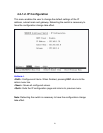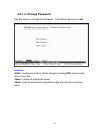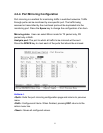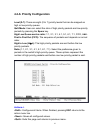34
4-3-5-1. VLAN Configure
Choose a VLAN
In the VLAN Configure menu select the type of VLAN you want to configure: VLAN
Disabled (default), Port Based VLAN, or IRRR802.1Q Tag based VLAN. Save the
configuration.
There are 3 different options for VLANs to choose from using
the space bar: Disabled, Port Based and 802.1Q.
To configure a new VLAN, select Edit and then use the tab key to select items you
want to configure. The space bar allows you to select the different options.
After adding a VLAN group, the configuration option Edit a VLAN Group will allow
you to change the membership by adding or deleting ports.
Port Based VLANs
These VLANs only apply to this switch. The VLANs can be overlapping, meaning
that any port can belong to more than one VLAN. One configuration that is
common for port based VLANs is to have all the ports on the switch on separate
VLANs except for the port that has the server connected. The port connected to
the server belongs to all the VLANs. This enables security between ports but
allows all ports access to the server. Up to 256 different port based VLANs may be
configured.
IEEE802.1Q VLANs
If IEEE802.1Q VLANs is selected, all the ports will belong to the default
VLAN 1.
If more than one VLAN is necessary, the additional VLANs may be created.
PVID (Port VID): Set the port VLAN ID that will be assigned to untagged
traffic on a given port. This feature is useful for accommodating devices that
you want to participate in the VLAN, but don’t support tagging. Only one
untagged VLAN is allowed per port. Other VLANs need to be tagged.


















